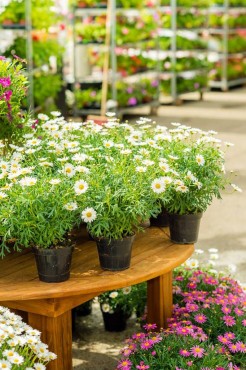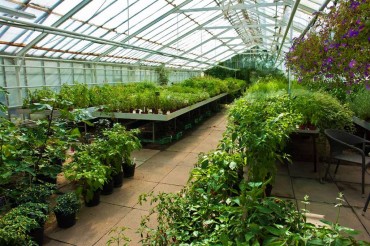From fall into spring is a great time to purchase and add plants to our landscapes. It’s also a great time to plant up some containers. But how do you choose good, strong, healthy plants?
Plant Selection
The first step is deciding what you’d want to plant and if you have time to take care of it. The motto “Right plant, right place” is a very good one.
Do you want a plant that will thrive in shade, partial shade or full sun? Do you want a plant that has lots of flowers or do you want good foliage attributes? Or both?
What about evergreen or deciduous? What color do you want for the foliage? What color of blooms would you like and what time of year do you want to enjoy the blooms? Do you want to spend time pruning a plant or just let it grow wild and free without any care other than watering when needed?
 Visiting the Nursery or Home Center
Visiting the Nursery or Home Center
I personally try to patronize our many local nurseries. But once in a while, I’ll purchase plants from the local home centers and big-box stores, and even local groceries and farmers markets. Master Gardeners and garden club plant sales are also a temptation and good way to find plants.
But how do you choose the right plant and assure that it’s healthy at initial purchase and planting time?
Pick up the plant in its container and if the container is too light and the roots are too densely packed or compact, or growing out the bottom of the container or over the sides, you’ll want to choose another plant.
The lightweight often means water has been running through the container without nourishing and hydrating the roots. Realize that some plants do quickly fill in their growing containers. Usually you want to look for a plant that can easily come out of the container but still have good soil clinging to the roots.
Note that some woody plants have roots that are wound around the sides of the container and are quite densely packed in the pot. If you can tease these roots apart and unwind them, snipping here and there in some cases to untangle and free them, the plant might be worth purchasing and taking home.
Avoiding Pests and Diseases
When choosing plants in containers, look under the leaves for insects or disease damage. Shake the pot a bit and if insects fly out, walk away from that plant. If you buy it, you’ll be transporting these insects home to infect the plants in your own garden.
Make sure the soil in the container isn’t too soggy and the pot doesn’t have water running out the drainage holes. Unless, of course, staff has just watered the plants. Too much watering destroys plant roots.
 Flowering Plants
Flowering Plants
My own personal rule of thumb when choosing flowering plants is to purchase them during the correct time of year when they’re blooming. Choose plants with some unopened blooms but definitely choose already blooming plants with lots of buds over plants that don’t have any visible blooms.
This way I know the plants will bloom again each year because they’ve reached the maturity to bloom. Younger, non-blooming plants sometimes require time and patience until they’re mature enough to bloom. Alas, this sometimes takes a few years. You’ll be enjoying the foliage, but not the blooming attributes of the plant.
Observations
Notice the nursery displays. Most nurseries have display gardens or display containers. Looking at these provides excellent ideas of how to group your own plant purchases and also shows how you might want to arrange them in your landscapes.
Ask nursery staff. They’re a great resource for ideas and tips. Find out what their favorite plants are in their own gardens and why.
Bringing the Plant Home
Try really hard to get your new plants into the ground as soon as you can. If you have to wait a few days, be sure to water the containers — usually once each day because containerized plants dry out quickly. Store these waiting containers in a shadier, somewhat sheltered section of your yard but not for too long. Plan on getting plants into the ground within a week (or two at the most).

























